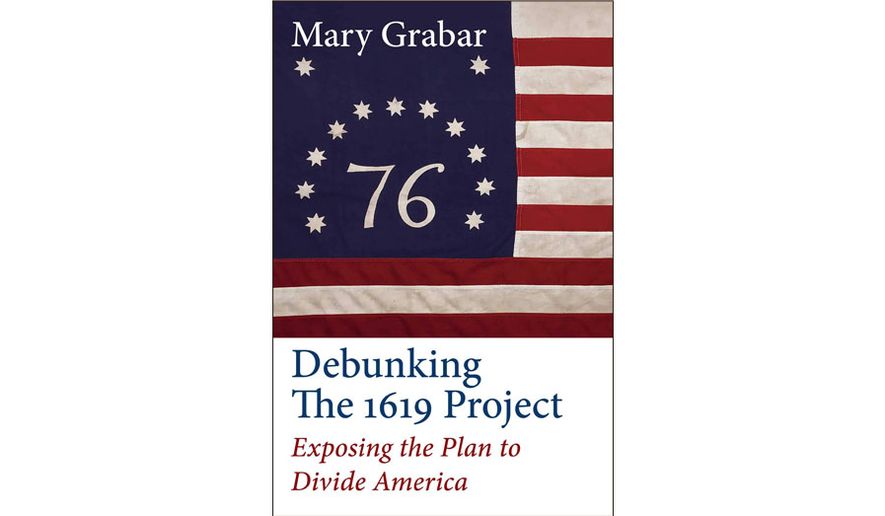OPINION:
One of author Nikole Hannah-Jones’ most advisable “memos to self” would be to never debate Dr. Mary Grabar on the former’s “1619 Project” and her claims that the toxic remnants of slavery have doomed the United States to be an irredeemably racist society.
The 1619 Project was created by Ms. Hannah-Jones, with the support of the New York Times. Her thesis boils down to this: America’s actual founding was not 1776’s Declaration of Independence but the arrival of the first Africans in 1619. Slavery’s impact, she posits, is so enduring that nothing, not a cataclysmic Civil War to free slaves, not the many powerful civil rights laws passed, not the death of Jim Crow, not the advancement of black leaders in almost every sector of American life, not even the elections of first a Black president and then a Black vice president, can cleanse this fatal sin and stain that mark American society, like a tattoo on the forehead.
The 1619 Project has been criticized by scores of professors, journalists, and Black leaders. Yet, the still-influential New York Times has persuaded 4,500 schools around the nation to include this dishonest take on history in the curricula of these gullible districts.
Incredibly, Ms. Hannah-Jones was awarded a Pulitzer Prize and gifted with a MacArthur Foundation “genius” prize and its no-strings-attached grant of $625,000. She now commands speaking fees of $25,000. These rewards for such weak offerings might make us forget that one president won a Nobel Peace Prize just weeks after taking office.
Ms. Hannah-Jones attacks Abraham Lincoln’s Gettysburg Address, where he references “this nation, conceived in liberty,” claiming we are, instead, a “slavocracy.” Ms. Grabar repeatedly invokes the great Frederick Douglass to rebut Ms. Hannah-Jones. While fervently condemning slavery, Mr. Douglass strongly praised the U. S. Constitution as “a glorious liberty document.”
A Civil War costing the lives of over 600,000 American soldiers brought liberation to slaves, setting an irreversible course toward that “more perfect” union and greater freedoms for all. Unlike African-Americans of that era, Ms. Hannah-Jones does not appear to rejoice in this at all. Blacks who disagree with her have been called “race traitors.”
One fact presented by Ms. Grabar is that thousands of free African-Americans owned slaves themselves, while African tribes sold rivals to slave traders, even as late as 1860.
American history is not as simple as Whites being “oppressors,” with all Blacks being “oppressed,” as “1619” suggests, Ms. Grabar points out. In New Orleans, “735 Negro masters owned five or more slaves” in 1830, reported historian John Blassingame. Blacks possessed swaths of real estate in 1850 New Orleans, with many owning groceries, import firms, banks, and other private enterprises.
One census revealed there were “nearly a thousand Black slave owners in Virginia.” Apparently, the treatment of slaves was not dependent on the race of the “master.” It was an immoral institution, period.
Other immigrants to our shores were also pressed into involuntary servitude. “Between 1700 and 1775, indentured servants made up 90%” of European immigrants, writes Ms. Grabar. Unsuspecting, non-English speaking Germans signed away their freedom to unscrupulous agents. Some were sent to the then-frontier in the Mohawk valley, where “many were killed by the Indians or enslaved by them,” notes Ms. Grabar.
Ms. Hannah-Jones suggests that the American economy was dependent on slave labor. Ms. Grabar illustrates how slavery actually stymied growth in the South.
Perhaps the most pernicious aspect of the 1619 Project is the actual harm it can do to young people. Non-Black youth, if persuaded that racism is “in their DNA,” might wrongly accept “collective guilt” for what some evil whites did well before they were born. Such an acceptance runs headlong into long-accepted Judeo-Christian principles of individual responsibility for one’s actions and inactions.
Even more harmful is the likely impact on Black young people, who might waste potential if they believe a “racist system” is hopelessly rigged against them.
The examples of African-American triumphs are everywhere, many in our own neighborhoods.
In New York City’s massive, diverse borough of Queens, the median income of Blacks has exceeded the White median. Similarly, Black-majority Prince Georges County, Maryland, features income levels of African-Americans on a near-par with white neighbors. Ms. Hannah-Jones simply side-steps these achievements.
Ms. Grabar has given us a decisive “debunking” of the indefensible inaccuracies from Nikole Hannah-Smith, the New York Times, and their 1619 Project.
Governor Andrew Cuomo’s “Emmy” award was rescinded when the truth about his behavior became known. Regarding the undeserved accolades bestowed on the 1619 Project, will the “Pulitzer” committee and the MacArthur Foundation follow suit now? Ms. Grabar’s book surely will give them food for thought.
• Herbert W. Stupp is the editor of Gipperten.com. He was a NYC Commissioner, 1994-2002, appointed by Mayor Rudy Giuliani.
• • •
Debunking the 1619 project: Exposing the plan to divide America
By Mary Grabar
Regnery History; 2021; 325 pages




Please read our comment policy before commenting.